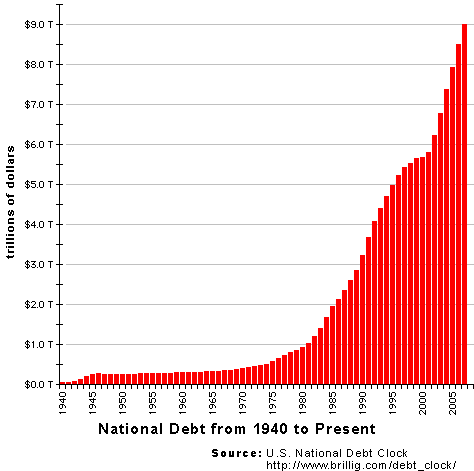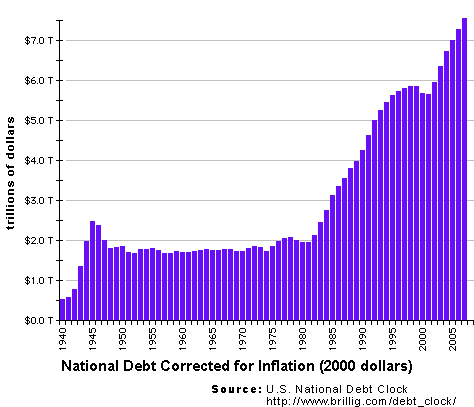National Debt is at $10 trillion
The National Debt is currently sitting at about $10 trillion as of the beginning of 2009.$10 trillion is a number that is impossible for most people to comprehend so I like to break it out and say “What’s your share of the National Debt?”
Your share of the National Debt is at $33,000
As of 2009 there are about 300 million people in the United States. If you divide $10 trillion by 300 million people every man, woman and child owes $33,333.33 towards the National Debt.And of course since children don’t usually pay taxes that means each and every adult in the USA owes roughly twice that or $66,666 as their share of the National Debt.
The equation to do the $10 trillion divide by 300 million people follows. A trillion dollars is 1000 billion dollars.
$10,000,000,000,000 / 300,000,000 people = $33,333.33That means that the mythical American family of four owes about $120,000 towards the National Debt. That is the cost of a small home in 2009 dollars.
$792 a month for 20 years to pays off your share
If that mythical family of 4 wanted to pay off their share of the National Debt how much would it cost them a month to get a 20 year loan and pay off the $120,000.On Feb 24, 2009 it would cost you $791.95 a month for a 20 year loan at 5% to pay your family of four $120,000 share of the National Debt off. I got the interest rate of 5% from Freddie Mac and used a mortgage caculator at LendingTree to do the math.
I suspect the National Debt will never paid off and we will just eat it in inflation costs, or Congress will run the printing presses to print money.
History of the National Debt
SourceThe graph shows that from 1791 to 1863 (Civil War) the national debt has pretty much been under $100 million. It's lowest point was $18,000 (yes thats correct 18 thousand dollars, not 18 million) in 1837 under Jackson. I don't know if the figures are adjusted for inflation.
Since 1938 the Democrats have held the White house for 35 years, the Republicans for 36. Over that time the national debt has increased at an average annual rate of 8.5%. In years Democrats were in the White House there was an average increase of 8.3%. In years the Republicans ran the White House the debt increased an average 9.2% per year.
Since 1946, Democratic presidents increased the national debt an average of only 3.2% per year. The Republican presidents stay at an average increase of 9.2% per year. Republican Presidents out borrowed and spent Democratic presidents by a three to one ratio.
[now doesn't that trash your image that Democrats are tax and spend theives, while Republicans are good guys who don't steal your money but force their religious values on you]
Since 1961 the United States national debt has never gone down.
These are the numbers for the USA National Debt from 1910 to 2005 as givin in wikipedia
| Year | Billions |
| 1910 | $3 |
| 1920 | $26 |
| 1930 | $16 |
| 1940 | $43 |
| 1950 | $257 |
| 1960 | $290 |
| 1970 | $389 |
| 1980 | $930 |
| 1990 | $3,233 |
| 2000 | $5,674 |
| 2005 | $7,933 |
| 2007 | $9,008 |
| 2008 | $10,699 |
From source
Q: How has the National Debt grown over time?
A: The National Debt on January 1st 1791 was just $75 million dollars. Today, it rises by that amount every hour or so. The following graph shows how the National Debt has grown year by year since 1940 in actual dollar amounts, uncorrected for inflation:
From time to time, I've gotten e-mail saying that the above graph is flawed -- it's just showing normal inflation. Well, I took the Debt numbers from the above graph and converted them all to 2000 dollars. Picking a different year would not have changed the shape of the graph below, just its height:
Money
What the Constitution says about money
SourceThere are seven main clauses of the Constitution that deal with the issue of “money”:
- Article I, Section 8, Clause 2. The Congress shall have Power…To borrow Money on the credit of the United States.
- Article I, Section 8, Clause 5. The Congress shall have Power…To coin Money, regulate the Value thereof, and of foreign Coin, and fix the Standard of Weights and Measures.
- Article I, Section 8, Clause 6. The Congress shall have Power…To provide for the Punishment of counterfeiting the Securities and current Coin of the United States.
- Article I, Section 9, Clause 1. The Migration or Importation of such Persons as any of the States now existing shall think proper to admit, shall not be prohibited by the Congress prior to the Year one thousand eight hundred and eight, but a Tax or duty may be imposed on such Importation, not exceeding ten dollars for each Person.
- Article I, Section 9, Clause 7. No Money shall be drawn from the Treasury, but in Consequence of Appropriations made by Law.
- Article I, Section 10, Clause 1. No State shall…coin Money; emit Bills of Credit; make any Thing but gold and silver Coin a Tender in Payment of Debt.
- Amendment VII. In Suits at common law, where the value in controversy shall exceed twenty dollars, the right of trial by jury shall be preserved…
What the Constitution doesn't say about money
Of particular interest is to note that the Constitution does not grant any of the following powers:- No power to print paper money
- No banking powers or regulations
- No mention of fractional reserve banking policies
- No power to loan money – only to borrow
- No power to create any paper currency regardless if it was redeemable in specie
- No power to delegate non-existing Constitutional powers to private corporations
- No power to grant charters of incorporation to banks
- No power to form monopolies
- No power to issue forced loans
- No power to draw money from the Treasury, but in consequence of appropriations by law
With the statement “No banking powers or regulations” and list of NO’s that follow they are saying that the Federal Reserve system is unconstitutional. The Feds don’t have the power to create money or loan money the way the Federal Reserve system does. ]
Silver standard? Gold Standard?
According to statute, the United States was on the silver standard. However, as we have seen, Congress also decreed that gold coins were to be minted and circulated along side of silver coins, and fixed the statutory valuation of silver to gold at 15 to 1.In other words, Congress had “fixed” the exchange rate between the two metals. Thus the United States was on a silver standard, but it was also on a bimetallic system of coinage, that included gold to be circulated at a “fixed” exchange rate to the silver standard.
Such a system can present problems, however, as the free market exchange rate between gold and silver can diverge from the statutory or legally fixed exchange rate – necessitating the adjustment of the other metals legal value up or down to conform to the statutory fixed rate of exchange.
Congress would have been better off to have simply minted gold Eagles without fixing a dollar value on them, thereby allowing the free market forces of supply and demand to regulate their exchange rate value. This would help prevent the “authorized” control by other than free market principles or by “others”.
Paper money was not printed till the Civil War
SourceOnce again the need to finance a war provided the impetus for a change in the monetary system. In 1861, to finance the Civil War, Congress authorized Demand Notes--the first issue of paper money by the government since the Continentals. These Notes were printed in $5, $10, and $20 denominations, redeemable in coins on demand, and green in color--hence the name "greenbacks."
[Of course the webmaster notes that all this printing of money during the Civil War was unconstitutional because as stated earlier the Constitution doesn’t give the Feds the power to print money. The Constitution only gives the Feds the power to COIN money. ]
In 1862, Congress discontinued issuing Demand Notes and issued Legal Tender Notes, also known as United States Notes. These new notes--issued in denominations from $1 to $1,000 (later $5,000 and $10,000)--were the first national currency used as legal tender for most public and private debts.
Gold certificates, colorful and vivid, were first issued in 1863 and put into general circulation in 1882. They are among the most attractive of all currency issues, with the reverse a brilliant golden orange, symbolic of the gold coin they represent. In 1933, when the country faced a severe depression and a banking crisis, the public began to demand gold.
In 1914, Federal Reserve Notes, which comprise more than 99 percent of today's paper money, were issued by Federal Reserve Banks as direct obligations of the Federal Reserve System.
[
And again the webmaster notes that the
Federal Reserve System
is unconstitutional because constitution says NO to these things:
]
FIAT Money?
Source – ME!Up until 1933 American money was backed by gold. You could take a $20 bill to the US. Treasury and exchange it for an ounce of gold. Roosevelt changed that and you could no longer exchange your money for gold.
In fact it was no longer legal to own gold and use it for money. You had to turn you gold into the government. And to get people to turn their gold into the government Roosevelt raised the price of gold to $32 an ounce from $20 and ounce.
The only legal use of gold was for medical purposes like filling in a tooth or for jewelry.
Up until the beginning of the 1970’s American money was backed by silver. You could take your money to the US Treasury and exchange it for silver. If you remember the old bills with the blue dots on them that said silver certificates, these bills were exchangeable for silver.
At the beginning of the 1970’s the American government stopped backing its money with gold and silver and American money became worthless fiat money.
Fiat money is a big word that means American money is the only source of legal tender but the government isn’t going to back it by anything! So the government can now let the printing presses run wildly because it doesn’t have to back money up with gold or silver.

